NX-TC
NX-series Temperature Control Unit
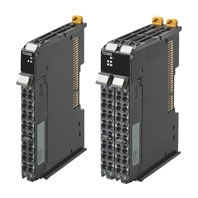
Optimize Control by Detecting Status Changes Easily Satisfy Both Productivity and Quality
- Features
- Lineup
- Specifications
- Dimensions
- Catalog / Manual / CAD / Software
last update: December 1, 2023
General Specifications
| Item | Specification | |
|---|---|---|
| Enclosure | Mounted in a panel | |
| Grounding method | Ground to 100 Ω or less | |
| Operating
environment |
Ambient operating temperature | 0 to 55°C |
| Ambient operating humidity | 10 to 95% (with no condensation or icing) | |
| Atmosphere | Must be free from corrosive gases. | |
| Ambient storage temperature | -25 to 70°C (with no condensation or icing) | |
| Altitude | 2,000 m max. | |
| Pollution degree | Pollution degree 2 or less: Conforms to JIS B 3502 and IEC 61131-2. | |
| Noise immunity | Conforms to IEC 61000-4-4, 2 kV (power supply line) | |
| Overvoltage category | Category II: Conforms to JIS B 3502 and IEC 61131-2. | |
| EMC immunity level | Zone B | |
| Vibration resistance | Conforms to IEC 60068-2-6.
5 to 8.4 Hz with amplitude of 3.5 mm, 8.4 to 150 Hz, acceleration of 9.8 m/s2 100 min each in X, Y, and Z directions (10 sweeps of 10 min each = 100 min total) |
|
| Shock resistance | Conforms to IEC 60068-2-27. 147 m/s2, 3 times each in X, Y, and Z
directions |
|
| Insulation resistance | 20 MΩ min. between isolated circuits (at 100 VDC) | |
| Dielectric strength | 510 VAC between isolated circuits for 1 minute at a leakage current
of 5 mA max. |
|
| Applicable standards * | cULus: Listed (UL 61010-2-201), ANSI/ISA 12.12.01,
EU: EN 61131-2, RCM, KC: KC Registration, NK, LR, BV, UKCA |
|
* Ask your OMRON representative for the most recent applicable standards for each model.
List of Functions
| Function name | Description | Applicable Units | |
|---|---|---|---|
| Free-Run Refreshing | With this I/O refreshing method, the refresh cycle of the NX
bus and the I/O refresh cycles of the NX Units are asynchronous. |
All models | |
| Selecting Channel To Use | This function disables control processing, error detection, and
output for unused channels. The conversion time for its own Unit will not be shortened even if errors are disabled. |
All models | |
| Input
Functions |
Input Type Setting | This function sets the input type of the sensor connected to
the temperature input. |
All models |
| Temperature Unit
Setting (°C/°F) |
This function sets the temperature units for measured values
to °C (Celsius) or °F (Fahrenheit). |
All models | |
| Decimal Point Position
Setting |
This function sets the number of digits to be displayed after
the decimal point for INT type measured values and set point parameters. |
All models | |
| Cold Junction
Compensation Enable/Disable Setting |
This function enables or disables cold junction compensation
using the cold junction sensor that is mounted on the terminal block when a thermocouple input is used. |
All models | |
| Temperature Input
Correction |
This function corrects measured values. When there are
variations in the sensor or when there is a difference in measured value from other measuring instruments. One-point correction and two-point correction methods are provided. |
All models | |
| Input Digital Filter | This function sets the time constant applied to the first-order
lag operation filter so that the noise components mixed with the measured value are eliminated. |
All models | |
| Measuring the Ambient
Temperature Around Terminals |
This function measures the temperature around the terminals
of the Temperature Control Unit. |
All models | |
| Control
Processing |
ON/OFF Control | This control function uses a preset set point to turn off the
control output when the temperature reaches the set point during control. |
All models |
| PID Control | PID control is a combination of proportional (P) control,
integral (I) control, and differential (D) control. It is a control function that feeds back the detected value to the set point so that they conform to each other. |
All models | |
| Heating/Cooling
Control |
This function controls both heating and cooling. | Heating/cooling
control type models |
|
| Run or Stop Controls | This function starts and stops temperature control. | All models | |
| Direct/Reverse
Operation |
This function specifies direct or reverse operation. | All models | |
| Manual MV (Manual
Manipulated Variable) |
This function outputs the specified manipulated variable
during PID control. |
All models | |
| MV at Error (error MV) | This function outputs a fixed manipulated variable when a
Sensor Disconnected Error occurs. |
All models | |
| MV Limit | This function adds a limit to the manipulated variable
calculated by PID control and outputs it. |
All models | |
| Load Rejection MV | This function performs a preset output operation if the
Temperature Control Unit connected to the CPU Unit cannot receive the output setting values from the CPU Unit due to an NX bus error or CPU watchdog timer error. This function performs a preset output operation if the Slave Terminal cannot receive the output setting values due to a communications error between the Temperature Control Unit and the Communications Coupler Unit host or due to an error on the NX bus. |
All models | |
| MV Branch *1 | The manipulated variables calculated by the slope or offset
are output to the branch-destination channel based on the manipulated variables of the branch-source channel. |
Standard control
type models |
|
| Load Short-circuit
Protection |
This function protects output circuits of the Temperature
Control Unit when an external device connected to the control output is short-circuited. |
Models with
voltage output (for driving SSR) |
|
| Disturbance
Suppression (Pre-boost) *2 |
This function suppresses temperature variations by adding a
preset manipulated variable before temperature variations occur due to a disturbance. |
Standard control
type models |
|
| Tuning | AT (Autotuning) | This is a tuning method that derives the PID constant. This
function automatically calculates the PID constant by the limit cycle method according to the characteristics of the control target. |
All models |
| Automatic Filter
Adjustment |
This is a tuning method that automatically adjusts the input
digital filter. This function is primarily for packing machines. It suppresses periodic temperature variations. |
Standard control
type models |
|
| Water-cooling Output
Adjustment |
This is a tuning method that automatically adjusts hunting.
This function is primarily for water-cooled extruders. It suppresses temperature variations caused by the cooling water output. |
Heating/cooling
control type models |
|
| Adaptive Control | This is a tuning method that can maintain high control
performance by following system changes. This function maintains control performance even if temperature variation factors such as environmental change and equipment deterioration occur during a long-term equipment operation. |
Standard control
type models |
|
| Notifying the Update of
Tuning Parameters |
This function notifies that the Temperature Control Unit has
automatically updated the parameters by tuning. |
All models | |
| D-AT
(Disturbance Autotuning) *2 |
This function automatically calculates disturbance suppression
(Preboost) function parameters such as FF waiting time, FF operation time, and FF segments 1 to 4 manipulated variables. |
Standard control
type models |
|
| Control
Output |
Control Period | This function sets the period when the ON/OFF time ratio is
changed for voltage output (for driving SSR) in time- proportional operation. |
Models with
voltage output (for driving SSR) |
| Minimum Output
ON/OFF Band |
This function specifies the minimum ON/OFF bands for the
heating side control output or the cooling side control output. This function can be used to prevent deterioration of mechanical relays when mechanical relays are used in the actuators connected to the output terminals. |
Models with
voltage output (for driving SSR) |
|
| Output Signal Range
Setting |
This function sets the output signal range of the linear current
output. You can specify 4 to 20 mA or 0 to 20 mA. |
Models with
linear current output |
|
| Limiting Simultaneous
Outputs |
This function limits the number of outputs that turn ON
simultaneously by shifting the control period of each output and restricting the upper limit of the manipulated variable. You can set a delay between outputs, which allows delays in output device operation that can occur when outputs are switched. |
Standard control
type models with voltage output (for driving SSR) |
|
| Error
Detection |
Sensor Disconnection
Detection |
This function detects disconnections in temperature sensors.
It also detects that the measured value of the temperature sensor is outside the input indication range. |
All models |
| Heater Burnout
Detection |
This function detects heater burnouts. A heater burnout is
detected if the control output is ON and the heater current is equal to or less than the heater burnout detection current. |
Models with CT
input |
|
| SSR Failure Detection | This function detects SSR failures. An SSR failure is detected
if the control output is OFF and the leakage current is equal to or greater than the SSR failure detection current. An SSR failure is a failure that is caused by an SSR short-circuit. |
Models with CT
input |
|
| Temperature Alarms *1 | Function for detecting a deviation or an error in the measured
value as an alarm. Alarm operation corresponding to the use can be performed by selecting “Alarm type”. |
All models | |
| LBA
(Loop Burnout Alarm) *1 |
Function for detecting, as an alarm, the error location in the
control loop when there is no change in the measured value while a control deviation equal to or more than the threshold value exists between the set point and the measured value. |
All models | |
*1. Can be used with Unit version Ver.1.1 or later.
*2. Can be used with Unit version Ver.1.2 or later.
Individual Specifications
Temperature Control Unit (2-Channel Type) NX-TC2405
| Unit name | Temperature Control Unit
(2-Channel Type) |
Model | NX-TC2405 | ||
|---|---|---|---|---|---|
| Number of Channels | 2 channels | Control type | Standard control | ||
| Number of points per
channel |
• Temperature input: 1 point
per channel (2 points per Unit) • CT Input: 1 point per channel (2 points per Unit) • Control Output: 1 point per channel (2 points per Unit) |
External connection
terminal |
Screwless clamping terminal
block (16 terminals) |
||
| I/O refreshing method | Free-Run Refreshing | ||||
| Indicators | TS indicator and output
indicators  |
CT
Input section |
CT current
input range |
0 to 0.125 A | |
| Input
resistance |
Approx. 2.7 Ω | ||||
| Connectable
CTs |
E54-CT1, E54-CT3,
E54-CT1L, and E54-CT3L |
||||
| Maximum
heater current |
50 A AC | ||||
| Resolution | 0.1 A | ||||
| Overall
accuracy (25°C) |
±5% (full scale) ±1 digit | ||||
| Influence of
temperature (0 to 55°C) |
±2% (full scale) ±1 digit | ||||
| Conversion
time |
50 ms per Unit | ||||
| Control
Output section |
Control output
type and number of control outputs per channel |
Voltage output for driving
SSR, 1 point per channel |
|||
| Internal I/O
common |
PNP | ||||
| Control Period | 0.1, 0.2, 0.5, 1 to 99s | ||||
| Manipulated
variable |
-5 to +105% | ||||
| Sensor
Input section |
Temperature
sensor *1 |
• Thermocouple input: K, J, T,
E, L, U, N, R, S, B, C/W, PL II • Platinum resistance thermometer input: Pt100 (three-wire), JPt100 (three-wire), Pt1000 (three-wire) |
Resolution | -- | |
| Input
conversion range |
±20°C of the input range | Rated Voltage | 24 VDC | ||
| Absolute
maximum rating |
±130 mV | Operating Load
Voltage Range |
15 to 28.8 VDC | ||
| Input
impedance |
20 kΩ min. | Maximum load
current |
21 mA per point, 42 mA per Unit | ||
| Resolution | 0.1°C max. | Maximum
Inrush Current |
0.3 A max. per point, 10 ms max. | ||
| Reference
accuracy |
*2 | Allowable load
resistance |
-- | ||
| Temperature
coefficient |
*2 | Leakage
current |
0.1 mA max. | ||
| Cold junction
compensation error |
±1.2°C *2 *3 | Residual
voltage |
1.5 V max. | ||
| Input
disconnection detection current |
Approx. 0.1 uA | Load Short-
circuit Protection |
Provided | ||
| Input
detection current |
0.25 mA | Output range | -- | ||
| Effect of
conductor resistance |
• Thermocouple input: 0.1°C/
Ω (100 Ω or less per conductor) • Platinum resistance thermometer input: 0.06°C/ Ω (20 Ω or less per conductor) |
Overall
accuracy (25°C) |
-- | ||
| Warm-up
period |
30 minutes | Influence of
temperature (0 to 55°C) |
-- | ||
| Conversion
time |
50 ms per Unit | ||||
| Dimensions | 12 mm (W) ×100 mm (H) ×
71 mm (D) |
Isolation method | • Between sensor inputs and
internal circuitry: Power = Transformer, Signal = Digital isolator • Between sensor inputs: Power = Transformer, Signal = Digital isolator • No isolation between internal circuits and CT inputs • Between control output and internal circuit: Photocoupler • No isolation between control outputs |
||
| Insulation resistance | 20 MΩ min. between isolated
circuits (at 100 VDC) |
Dielectric strength | 510 VAC between isolated
circuits for 1 minute with a leakage current of 5 mA max. |
||
| I/O power supply
method |
Supplied from the NX bus. | Current capacity of I/O
power supply terminals |
IOG: 0.1 A max. per terminal | ||
| NX Unit power
consumption |
• Connected to a CPU Unit
1.45 W max. • Connected to Communications Coupler Unit 1.10 W max. |
Current consumption
from I/O power supply |
20 mA max. | ||
| Weight | 75 g max. | ||||
| Circuit configuration | 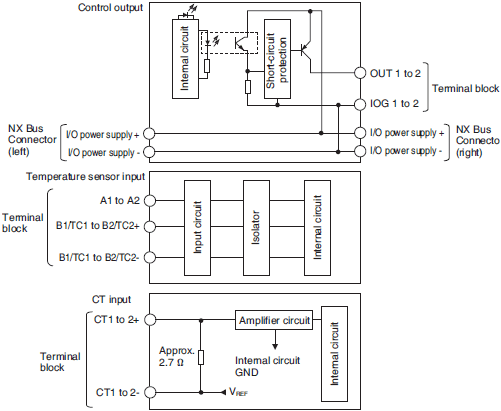 |
||||
| Installation orientation
and restrictions |
Mounting orientation:
• Connect to CPU Unit Front mounting orientation is possible • Connect to Communications Coupler Unit Six orientations are possible Limitation: The cold junction compensation error is limited by the mounting orientation and the type or power consumption of the adjacent Unit. For details, refer to Cold Junction Compensation Error Specifications for Units That Take a Thermocouple Input Type. |
||||
| Terminal connection
diagram |
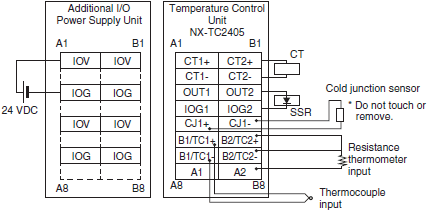 |
||||
*2. For details, refer to the Reference Accuracy and Temperature Coefficient Table.
For thermocouple inputs, reference accuracy and cold junction compensation error are guaranteed for a set of a
Temperature Control Unit and a terminal block on which a cold junction sensor is mounted.
Be sure to use the terminal block and the Temperature Control Unit with the same calibration control number
together.
A calibration control number is displayed both on the terminal block and the Unit.
Make sure to return the terminal block to which a cold junction sensor is mounted and the Unit together.
*3. For details, refer to Cold Junction Compensation Error Specifications for Units That Take a Thermocouple Input Type.
Temperature Control Unit (2-Channel Type) NX-TC2406
| Unit name | Temperature Control Unit
(2-Channel Type) |
Model | NX-TC2406 | ||
|---|---|---|---|---|---|
| Number of Channels | 2 channels | Control type | Standard control | ||
| Number of points per
channel |
• Temperature input: 1 point
per channel (2 points per Unit) • CT input: None • Control Output: 1 point per channel (2 points per Unit) |
External connection
terminal |
Screwless clamping terminal
block (16 terminals) |
||
| I/O refreshing method | Free-Run Refreshing | ||||
| Indicators | TS indicator and output
indicators  |
CT
Input section |
CT current
input range |
-- | |
| Input
resistance |
-- | ||||
| Connectable
CTs |
-- | ||||
| Maximum
heater current |
-- | ||||
| Resolution | -- | ||||
| Overall
accuracy (25°C) |
-- | ||||
| Influence of
temperature (0 to 55°C) |
-- | ||||
| Conversion
time |
-- | ||||
| Control
Output section |
Control output
type and number of control outputs per channel |
Voltage output for driving
SSR, 1 point per channel |
|||
| Internal I/O
common |
PNP | ||||
| Control Period | 0.1, 0.2, 0.5, 1 to 99s | ||||
| Manipulated
variable |
-5 to +105% | ||||
| Sensor
Input section |
Temperature
sensor *1 |
• Thermocouple input: K, J, T,
E, L, U, N, R, S, B, C/W, PL II • Platinum resistance thermometer input: Pt100 (three-wire), JPt100 (three-wire), Pt1000 (three-wire) |
Resolution | -- | |
| Input
conversion range |
±20°C of the input range
*2 |
Rated Voltage | 24 VDC | ||
| Absolute
maximum rating |
±130 mV | Operating Load
Voltage Range |
15 to 28.8 VDC | ||
| Input
impedance |
20 kΩ min. | Maximum load
current |
21 mA per point, 42 mA per Unit | ||
| Resolution | 0.1°C max. | Maximum
Inrush Current |
0.3 A max. per point, 10 ms max. | ||
| Reference
accuracy |
*2 | Allowable load
resistance |
-- | ||
| Temperature
coefficient |
*2 | Leakage
current |
0.1 mA max. | ||
| Cold junction
compensation error |
±1.2°C *2 *3 | Residual
voltage |
1.5 V max. | ||
| Input
disconnection detection current |
Approx. 0.1 uA | Load Short-
circuit Protection |
Provided | ||
| Input
detection current |
0.25 mA | Output range | -- | ||
| Effect of
conductor resistance |
• Thermocouple input: 0.1°C/
Ω (100 Ω or less per conductor) • Platinum resistance thermometer input: 0.06°C/ Ω (20 Ω or less per conductor) |
Overall
accuracy (25°C) |
-- | ||
| Warm-up
period |
30 minutes | Influence of
temperature (0 to 55°C) |
-- | ||
| Conversion
time |
50 ms per Unit | ||||
| Dimensions | 12 mm (W) ×100 mm (H) ×
71 mm (D) |
Isolation method | • Between sensor inputs and
internal circuitry: Power = Transformer, Signal = Digital isolator • Between sensor inputs: Power = Transformer, Signal = Digital isolator • Between control output and internal circuit: Photocoupler • No isolation between control outputs |
||
| Insulation resistance | 20 MΩ min. between isolated
circuits (at 100 VDC) |
Dielectric strength | 510 VAC between isolated
circuits for 1 minute with a leakage current of 5 mA max. |
||
| I/O power supply
method |
Supplied from the NX bus. | Current capacity of I/O
power supply terminals |
IOG: 0.1 A max. per terminal | ||
| NX Unit power
consumption |
• Connected to a CPU Unit
1.25 W max. • Connected to Communications Coupler Unit 0.95 W max. |
Current consumption
from I/O power supply |
20 mA max. | ||
| Weight | 75 g max. | ||||
| Circuit configuration | 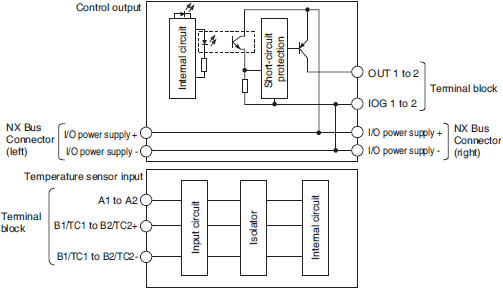 |
||||
| Installation orientation
and restrictions |
Mounting orientation:
• Connect to CPU Unit Front mounting orientation is possible • Connect to Communications Coupler Unit Six orientations are possible Limitation: The cold junction compensation error is limited by the mounting orientation and the type or power consumption of the adjacent Unit. For details, refer to Cold Junction Compensation Error Specifications for Units That Take a Thermocouple Input Type. |
||||
| Terminal connection
diagram |
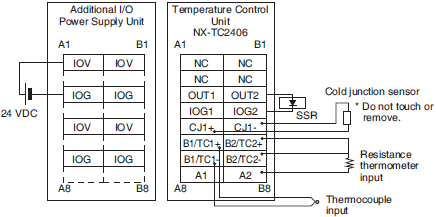 |
||||
*2. For details, refer to the Reference Accuracy and Temperature Coefficient Table.
For thermocouple inputs, reference accuracy and cold junction compensation error are guaranteed for a set of a
Temperature Control Unit and a terminal block on which a cold junction sensor is mounted.
Be sure to use the terminal block and the Temperature Control Unit with the same calibration control number
together.
A calibration control number is displayed both on the terminal block and the Unit.
Make sure to return the terminal block to which a cold junction sensor is mounted and the Unit together.
*3. For details, refer to Cold Junction Compensation Error Specifications for Units That Take a Thermocouple Input Type.
Temperature Control Unit (2-Channel Type) NX-TC2407
| Unit name | Temperature Control Unit
(2-Channel Type) |
Model | NX-TC2407 | ||
|---|---|---|---|---|---|
| Number of Channels | 2 channels | Control type | Heating and cooling control | ||
| Number of points per
channel |
• Temperature input: 1 point
per channel (2 points per Unit) • CT input: None • Control Output: 2 point per channel (4 points per Unit) |
External connection
terminal |
Screwless clamping terminal
block (16 terminals) |
||
| I/O refreshing method | Free-Run Refreshing | ||||
| Indicators | TS indicator and output
indicators  |
CT
Input section |
CT current
input range |
-- | |
| Input
resistance |
-- | ||||
| Connectable
CTs |
-- | ||||
| Maximum
heater current |
-- | ||||
| Resolution | -- | ||||
| Overall
accuracy (25°C) |
-- | ||||
| Influence of
temperature (0 to 55°C) |
-- | ||||
| Conversion
time |
-- | ||||
| Control
Output section |
Control output
type and number of control outputs per channel |
Voltage output for driving
SSR, 2 point per channel |
|||
| Internal I/O
common |
PNP | ||||
| Control Period | 0.1, 0.2, 0.5, 1 to 99s | ||||
| Manipulated
variable |
• Heating: 0 to +105%
• Cooling: 0 to +105% |
||||
| Sensor
Input section |
Temperature
sensor *1 |
• Thermocouple input: K, J, T,
E, L, U, N, R, S, B, C/W, PL II • Platinum resistance thermometer input: Pt100 (three-wire), JPt100 (three-wire), Pt1000 (three-wire) |
Resolution | -- | |
| Input
conversion range |
±20°C of the input range
*2 |
Rated Voltage | 24 VDC | ||
| Absolute
maximum rating |
±130 mV | Operating Load
Voltage Range |
15 to 28.8 VDC | ||
| Input
impedance |
20 kΩ min. | Maximum load
current |
21 mA per point, 84 mA per Unit | ||
| Resolution | 0.1°C max. | Maximum
Inrush Current |
0.3 A max. per point, 10 ms max. | ||
| Reference
accuracy |
*2 | Allowable load
resistance |
-- | ||
| Temperature
coefficient |
*2 | Leakage
current |
0.1 mA max. | ||
| Cold junction
compensation error |
±1.2°C *2 *3 | Residual
voltage |
1.5 V max. | ||
| Input
disconnection detection current |
Approx. 0.1 uA | Load Short-
circuit Protection |
Provided | ||
| Input
detection current |
0.25 mA | Output range | -- | ||
| Effect of
conductor resistance |
• Thermocouple input: 0.1°C/
Ω (100 Ω or less per conductor) • Platinum resistance thermometer input: 0.06°C/ Ω (20 Ω or less per conductor) |
Overall
accuracy (25°C) |
-- | ||
| Warm-up
period |
30 minutes | Influence of
temperature (0 to 55°C) |
-- | ||
| Conversion
time |
50 ms per Unit | ||||
| Dimensions | 12 mm (W) ×100 mm (H) ×
71 mm (D) |
Isolation method | • Between sensor inputs and
internal circuitry: Power = Transformer, Signal = Digital isolator • Between sensor inputs: Power = Transformer, Signal = Digital isolator • Between control output and internal circuit: Photocoupler • No isolation between control outputs |
||
| Insulation resistance | 20 MΩ min. between isolated
circuits (at 100 VDC) |
Dielectric strength | 510 VAC between isolated
circuits for 1 minute with a leakage current of 5 mA max. |
||
| I/O power supply
method |
Supplied from the NX bus. | Current capacity of I/O
power supply terminals |
IOG: 0.1 A max. per terminal | ||
| NX Unit power
consumption |
• Connected to a CPU Unit
1.30 W max. • Connected to Communications Coupler Unit 1.00 W max. |
Current consumption
from I/O power supply |
20 mA max. | ||
| Weight | 75 g max. | ||||
| Circuit configuration | 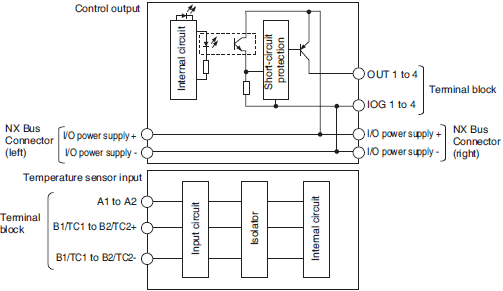 |
||||
| Installation orientation
and restrictions |
Mounting orientation:
• Connect to CPU Unit Front mounting orientation is possible • Connect to Communications Coupler Unit Six orientations are possible Limitation: The cold junction compensation error is limited by the mounting orientation and the type or power consumption of the adjacent Unit. For details, refer to Cold Junction Compensation Error Specifications for Units That Take a Thermocouple Input Type. |
||||
| Terminal connection
diagram |
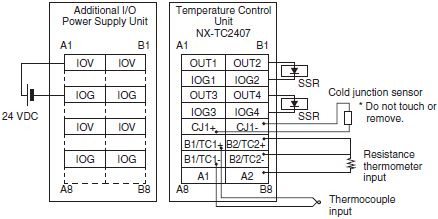 |
||||
*2. For details, refer to the Reference Accuracy and Temperature Coefficient Table.
For thermocouple inputs, reference accuracy and cold junction compensation error are guaranteed for a set of a
Temperature Control Unit and a terminal block on which a cold junction sensor is mounted.
Be sure to use the terminal block and the Temperature Control Unit with the same calibration control number
together.
A calibration control number is displayed both on the terminal block and the Unit.
Make sure to return the terminal block to which a cold junction sensor is mounted and the Unit together.
*3. For details, refer to Cold Junction Compensation Error Specifications for Units That Take a Thermocouple Input Type.
Temperature Control Unit (2-Channel Type) NX-TC2408
| Unit name | Temperature Control Unit
(2-Channel Type) |
Model | NX-TC2408 | ||
|---|---|---|---|---|---|
| Number of Channels | 2 channels | Control type | Standard control | ||
| Number of points per
channel |
• Temperature input: 1 point
per channel (2 points per Unit) • CT input: None • Control Output: 1 point per channel (2 points per Unit) |
External connection
terminal |
Screwless clamping terminal
block (16 terminals) |
||
| I/O refreshing method | Free-Run Refreshing | ||||
| Indicators | TS indicator and output
indicators  |
CT
Input section |
CT current
input range |
-- | |
| Input
resistance |
-- | ||||
| Connectable
CTs |
-- | ||||
| Maximum
heater current |
-- | ||||
| Resolution | -- | ||||
| Overall
accuracy (25°C) |
-- | ||||
| Influence of
temperature (0 to 55°C) |
-- | ||||
| Conversion
time |
-- | ||||
| Control
Output section |
Control output
type and number of control outputs per channel |
Linear current output, one
output per channel |
|||
| Internal I/O
common |
-- | ||||
| Control Period | -- | ||||
| Manipulated
variable |
-5 to +105% | ||||
| Sensor
Input section |
Temperature
sensor *1 |
• Thermocouple input: K, J, T,
E, L, U, N, R, S, B, C/W, PL II • Platinum resistance thermometer input: Pt100 (three-wire), JPt100 (three-wire), Pt1000 (three-wire) |
Resolution | 1/10,000 | |
| Input
conversion range |
±20°C of the input range
*2 |
Rated Voltage | 24 VDC | ||
| Absolute
maximum rating |
±130 mV | Operating Load
Voltage Range |
15 to 28.8 VDC | ||
| Input
impedance |
20 kΩ min. | Maximum load
current |
-- | ||
| Resolution | 0.1°C max. | Maximum
Inrush Current |
-- | ||
| Reference
accuracy |
*2 | Allowable load
resistance |
350 Ω or less, or greater than
350 Ω but no more than 600 Ω *3 |
||
| Temperature
coefficient |
*2 | Leakage
current |
-- | ||
| Cold junction
compensation error |
±1.2°C *2 *4 | Residual
voltage |
-- | ||
| Input
disconnection detection current |
Approx. 0.1 uA | Load Short-
circuit Protection |
-- | ||
| Input
detection current |
0.25 mA | Output range | 0 to 20 mA, 4 to 20 mA | ||
| Effect of
conductor resistance |
• Thermocouple input: 0.1°C/
Ω (100 Ω or less per conductor) • Platinum resistance thermometer input: 0.06°C/ Ω (20 Ω or less per conductor) |
Overall
accuracy (25°C) |
±0.3% of full scale, but 1% of
full scale at 0 to 4 mA of 0 to 20 mA range |
||
| Warm-up
period |
30 minutes | Influence of
temperature (0 to 55°C) |
±0.3% (full scale) | ||
| Conversion
time |
50 ms per Unit | ||||
| Dimensions | 12 mm (W) ×100 mm (H) ×
71 mm (D) |
Isolation method | • Between sensor inputs and
internal circuitry: Power = Transformer, Signal = Digital isolator • Between sensor inputs: Power = Transformer, Signal = Digital isolator • Between control output and internal circuit: Photocoupler • No isolation between control outputs |
||
| Insulation resistance | 20 MΩ min. between isolated
circuits (at 100 VDC) |
Dielectric strength | 510 VAC between isolated
circuits for 1 minute with a leakage current of 5 mA max. |
||
| I/O power supply
method |
Supplied from the NX bus. | Current capacity of I/O
power supply terminals |
IOG: 0.1 A max. per terminal | ||
| NX Unit power
consumption |
• Connected to a CPU Unit
1.25 W max. • Connected to Communications Coupler Unit 0.95 W max. |
Current consumption
from I/O power supply |
20 mA max. | ||
| Weight | 75 g max. | ||||
| Circuit configuration | 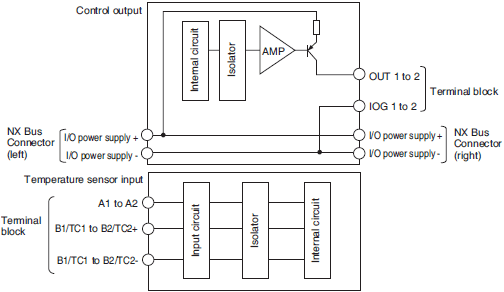 |
||||
| Installation orientation
and restrictions |
Mounting orientation:
• Connect to CPU Unit Front mounting orientation is possible • Connect to Communications Coupler Unit Six orientations are possible Limitation: The cold junction compensation error is limited by the mounting orientation and the type or power consumption of the adjacent Unit. For details, refer to Cold Junction Compensation Error Specifications for Units That Take a Thermocouple Input Type. |
||||
| Terminal connection
diagram |
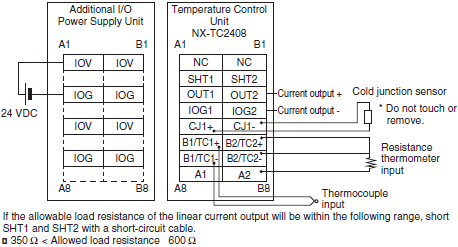 |
||||
*2. For details, refer to the Reference Accuracy and Temperature Coefficient Table.
For thermocouple inputs, reference accuracy and cold junction compensation error are guaranteed for a set of a
Temperature Control Unit and a terminal block on which a cold junction sensor is mounted.
Be sure to use the terminal block and the Temperature Control Unit with the same calibration control number
together.
A calibration control number is displayed both on the terminal block and the Unit.
Make sure to return the terminal block to which a cold junction sensor is mounted and the Unit together.
*3. To use an allowable load resistance greater than 350 Ω but not exceeding 600 Ω, SHT1 and SHT2 must be shorted
with a shorting cable.
For details, refer to the NX-series Temperature Control Units User’s Manual (Cat. No. W523).
*4. For details, refer to Cold Junction Compensation Error Specifications for Units That Take a Thermocouple Input Type.
Temperature Control Unit (4-Channel Type) NX-TC3405
| Unit name | Temperature Control Unit
(4-Channel Type) |
Model | NX-TC3405 | ||
|---|---|---|---|---|---|
| Number of Channels | 4 channels | Control type | Standard control | ||
| Number of points per
channel |
• Temperature input: 1 point
per channel (4 points per Unit) • CT Input: 1 point per channel (4 points per Unit) • Control Output: 1 point per channel (4 points per Unit) |
External connection
terminal |
Screwless clamping terminal
block (16 terminals x 2) |
||
| I/O refreshing method | Free-Run Refreshing | ||||
| Indicators | TS indicator and output
indicators  |
CT
Input section |
CT current
input range |
0 to 0.125 A | |
| Input
resistance |
Approx. 2.7 Ω | ||||
| Connectable
CTs |
E54-CT1, E54-CT3,
E54-CT1L, and E54-CT3L |
||||
| Maximum
heater current |
50 A AC | ||||
| Resolution | 0.1 A | ||||
| Overall
accuracy (25°C) |
±5% (full scale) ±1 digit | ||||
| Influence of
temperature (0 to 55°C) |
±2% (full scale) ±1 digit | ||||
| Conversion
time |
50 ms per Unit | ||||
| Control
Output section |
Control output
type and number of control outputs per channel |
Voltage output for driving
SSR, 1 point per channel |
|||
| Internal I/O
common |
PNP | ||||
| Control Period | 0.1, 0.2, 0.5, 1 to 99s | ||||
| Manipulated
variable |
-5 to +105% | ||||
| Sensor
Input section |
Temperature
sensor *1 |
• Thermocouple input: K, J, T,
E, L, U, N, R, S, B, C/W, PL II • Platinum resistance thermometer input: Pt100 (three-wire), JPt100 (three-wire), Pt1000 (three-wire) |
Resolution | -- | |
| Input
conversion range |
±20°C of the input range
*2 |
Rated Voltage | 24 VDC | ||
| Absolute
maximum rating |
±130 mV | Operating Load
Voltage Range |
15 to 28.8 VDC | ||
| Input
impedance |
20 kΩ min. | Maximum load
current |
21 mA per point, 84 mA per Unit | ||
| Resolution | 0.1°C max. | Maximum
Inrush Current |
0.3 A max. per point, 10 ms max. | ||
| Reference
accuracy |
*2 | Allowable load
resistance |
-- | ||
| Temperature
coefficient |
*2 | Leakage
current |
0.1 mA max. | ||
| Cold junction
compensation error |
±1.2°C *2 *3 | Residual
voltage |
1.5 V max. | ||
| Input
disconnection detection current |
Approx. 0.1 uA | Load Short-
circuit Protection |
Provided | ||
| Input
detection current |
0.25 mA | Output range | -- | ||
| Effect of
conductor resistance |
• Thermocouple input: 0.1°C/
Ω (100 Ω or less per conductor) • Platinum resistance thermometer input: 0.06°C/ Ω (20 Ω or less per conductor) |
Overall
accuracy (25°C) |
-- | ||
| Warm-up
period |
30 minutes | Influence of
temperature (0 to 55°C) |
-- | ||
| Conversion
time |
50 ms per Unit | ||||
| Dimensions | 24 mm (W) ×100 mm (H) ×
71 mm (D) |
Isolation method | • Between sensor inputs and
internal circuitry: Power = Transformer, Signal = Digital isolator • Between sensor inputs: Power = Transformer, Signal = Digital isolator • No isolation between internal circuits and CT inputs • Between control output and internal circuit: Photocoupler • No isolation between control outputs |
||
| Insulation resistance | 20 MΩ min. between isolated
circuits (at 100 VDC) |
Dielectric strength | 510 VAC between isolated
circuits for 1 minute with a leakage current of 5 mA max. |
||
| I/O power supply
method |
Supplied from the NX bus. | Current capacity of I/O
power supply terminals |
IOG: 0.1 A max. per terminal | ||
| NX Unit power
consumption |
• Connected to a CPU Unit
1.80 W max. • Connected to Communications Coupler Unit 1.35 W max. |
Current consumption
from I/O power supply |
20 mA max. | ||
| Weight | 140 g max. | ||||
| Circuit configuration | 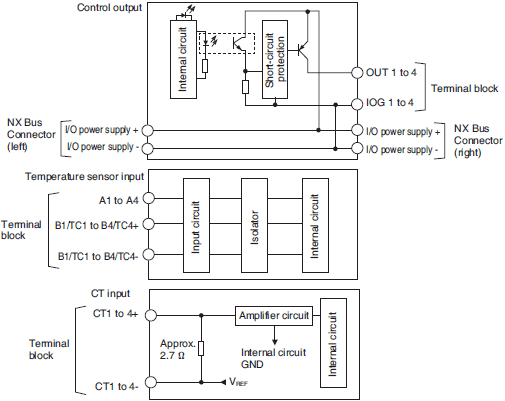 |
||||
| Installation orientation
and restrictions |
Mounting orientation:
• Connect to CPU Unit Front mounting orientation is possible • Connect to Communications Coupler Unit Six orientations are possible Limitation: The cold junction compensation error is limited by the mounting orientation and the type or power consumption of the adjacent Unit. For details, refer to Cold Junction Compensation Error Specifications for Units That Take a Thermocouple Input Type. |
||||
| Terminal connection
diagram |
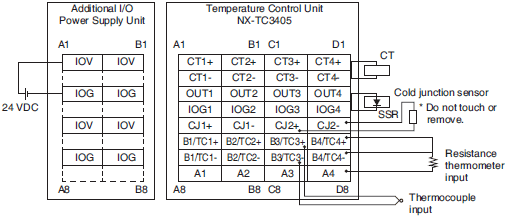 |
||||
*2. For details, refer to the Reference Accuracy and Temperature Coefficient Table.
For thermocouple inputs, reference accuracy and cold junction compensation error are guaranteed for a set of a
Temperature Control Unit and a terminal block on which a cold junction sensor is mounted.
Be sure to use the terminal block and the Temperature Control Unit with the same calibration control number
together.
A calibration control number is displayed both on the terminal block and the Unit.
In order to distinguish left and right terminal blocks, each terminal block has either a letter "L" (left side) or "R" (right
side) appended at the end of a calibration control number.
Make sure to return the terminal block to which a cold junction sensor is mounted and the Unit together.
*3. For details, refer to Cold Junction Compensation Error Specifications for Units That Take a Thermocouple Input Type.
Temperature Control Unit (4-Channel Type) NX-TC3406
| Unit name | Temperature Control Unit
(4-Channel Type) |
Model | NX-TC3406 | ||
|---|---|---|---|---|---|
| Number of Channels | 4 channels | Control type | Standard control | ||
| Number of points per
channel |
• Temperature input: 1 point
per channel (4 points per Unit) • CT input: None • Control Output: 1 point per channel (4 points per Unit) |
External connection
terminal |
Screwless clamping terminal
block (16 terminals x 2) |
||
| I/O refreshing method | Free-Run Refreshing | ||||
| Indicators | TS indicator and output
indicators  |
CT
Input section |
CT current
input range |
-- | |
| Input
resistance |
-- | ||||
| Connectable
CTs |
-- | ||||
| Maximum
heater current |
-- | ||||
| Resolution | -- | ||||
| Overall
accuracy (25°C) |
-- | ||||
| Influence of
temperature (0 to 55°C) |
-- | ||||
| Conversion
time |
-- | ||||
| Control
Output section |
Control output
type and number of control outputs per channel |
Voltage output for driving
SSR, 1 point per channel |
|||
| Internal I/O
common |
PNP | ||||
| Control Period | 0.1, 0.2, 0.5, 1 to 99s | ||||
| Manipulated
variable |
-5 to +105% | ||||
| Sensor
Input section |
Temperature
sensor *1 |
• Thermocouple input: K, J, T,
E, L, U, N, R, S, B, C/W, PL II • Platinum resistance thermometer input: Pt100 (three-wire), JPt100 (three-wire), Pt1000 (three-wire) |
Resolution | -- | |
| Input
conversion range |
±20°C of the input range
*2 |
Rated Voltage | 24 VDC | ||
| Absolute
maximum rating |
±130 mV | Operating Load
Voltage Range |
15 to 28.8 VDC | ||
| Input
impedance |
20 kΩ min. | Maximum load
current |
21 mA per point, 84 mA per Unit | ||
| Resolution | 0.1°C max. | Maximum
Inrush Current |
0.3 A max. per point, 10 ms max. | ||
| Reference
accuracy |
*2 | Allowable load
resistance |
-- | ||
| Temperature
coefficient |
*2 | Leakage
current |
0.1 mA max. | ||
| Cold junction
compensation error |
±1.2°C *2 *3 | Residual
voltage |
1.5 V max. | ||
| Input
disconnection detection current |
Approx. 0.1 uA | Load Short-
circuit Protection |
Provided | ||
| Input
detection current |
0.25 mA | Output range | -- | ||
| Effect of
conductor resistance |
• Thermocouple input: 0.1°C/
Ω (100 Ω or less per conductor) • Platinum resistance thermometer input: 0.06°C/ Ω (20 Ω or less per conductor) |
Overall
accuracy (25°C) |
-- | ||
| Warm-up
period |
30 minutes | Influence of
temperature (0 to 55°C) |
-- | ||
| Conversion
time |
50 ms per Unit | ||||
| Dimensions | 24 mm (W) ×100 mm (H) ×
71 mm (D) |
Isolation method | • Between sensor inputs and
internal circuitry: Power = Transformer, Signal = Digital isolator • Between sensor inputs: Power = Transformer, Signal = Digital isolator • Between control output and internal circuit: Photocoupler • No isolation between control outputs |
||
| Insulation resistance | 20 MΩ min. between isolated
circuits (at 100 VDC) |
Dielectric strength | 510 VAC between isolated
circuits for 1 minute with a leakage current of 5 mA max. |
||
| I/O power supply
method |
Supplied from the NX bus. | Current capacity of I/O
power supply terminals |
IOG: 0.1 A max. per terminal | ||
| NX Unit power
consumption |
• Connected to a CPU Unit
1.70 W max. • Connected to Communications Coupler Unit 1.25 W max. |
Current consumption
from I/O power supply |
20 mA max. | ||
| Weight | 140 g max. | ||||
| Circuit configuration | 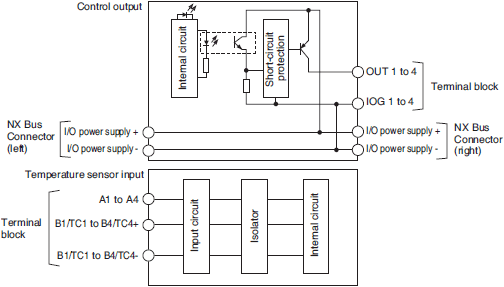 |
||||
| Installation orientation
and restrictions |
Mounting orientation:
• Connect to CPU Unit Front mounting orientation is possible • Connect to Communications Coupler Unit Six orientations are possible Limitation: The cold junction compensation error is limited by the mounting orientation and the type or power consumption of the adjacent Unit. For details, refer to Cold Junction Compensation Error Specifications for Units That Take a Thermocouple Input Type. |
||||
| Terminal connection
diagram |
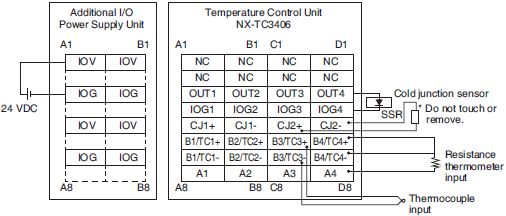 |
||||
*2. For details, refer to the Reference Accuracy and Temperature Coefficient Table.
For thermocouple inputs, reference accuracy and cold junction compensation error are guaranteed for a set of a
Temperature Control Unit and a terminal block on which a cold junction sensor is mounted.
Be sure to use the terminal block and the Temperature Control Unit with the same calibration control number
together.
A calibration control number is displayed both on the terminal block and the Unit.
In order to distinguish left and right terminal blocks, each terminal block has either a letter "L" (left side) or "R" (right
side) appended at the end of a calibration control number.
Make sure to return the terminal block to which a cold junction sensor is mounted and the Unit together.
*3. For details, refer to Cold Junction Compensation Error Specifications for Units That Take a Thermocouple Input Type.
Temperature Control Unit (4-Channel Type) NX-TC3407
| Unit name | Temperature Control Unit
(4-Channel Type) |
Model | NX-TC3407 | ||
|---|---|---|---|---|---|
| Number of Channels | 4 channels | Control type | heating and cooling control | ||
| Number of points per
channel |
• Temperature input: 1 point
per channel (4 points per Unit) • CT input: None • Control Output: 2 point per channel (8 points per Unit) |
External connection
terminal |
Screwless clamping terminal
block (16 terminals x 2) |
||
| I/O refreshing method | Free-Run Refreshing | ||||
| Indicators | TS indicator and output
indicators  |
CT
Input section |
CT current
input range |
-- | |
| Input
resistance |
-- | ||||
| Connectable
CTs |
-- | ||||
| Maximum
heater current |
-- | ||||
| Resolution | -- | ||||
| Overall
accuracy (25°C) |
-- | ||||
| Influence of
temperature (0 to 55°C) |
-- | ||||
| Conversion
time |
-- | ||||
| Control
Output section |
Control output
type and number of control outputs per channel |
Voltage output for driving
SSR, 2 point per channel |
|||
| Internal I/O
common |
PNP | ||||
| Control Period | 0.1, 0.2, 0.5, 1 to 99s | ||||
| Manipulated
variable |
• Heating: 0 to +105%
• Cooling: 0 to +105% |
||||
| Sensor
Input section |
Temperature
sensor *1 |
• Thermocouple input: K, J, T,
E, L, U, N, R, S, B, C/W, PL II • Platinum resistance thermometer input: Pt100 (three-wire), JPt100 (three-wire), Pt1000 (three-wire) |
Resolution | -- | |
| Input
conversion range |
±20°C of the input range
*2 |
Rated Voltage | 24 VDC | ||
| Absolute
maximum rating |
±130 mV | Operating Load
Voltage Range |
15 to 28.8 VDC | ||
| Input
impedance |
20 kΩ min. | Maximum load
current |
21 mA per point, 168 mA per Unit | ||
| Resolution | 0.1°C max. | Maximum
Inrush Current |
0.3 A max. per point, 10 ms max. | ||
| Reference
accuracy |
*2 | Allowable load
resistance |
-- | ||
| Temperature
coefficient |
*2 | Leakage
current |
0.1 mA max. | ||
| Cold junction
compensation error |
±1.2°C *2 *3 | Residual
voltage |
1.5 V max. | ||
| Input
disconnection detection current |
Approx. 0.1 uA | Load Short-
circuit Protection |
Provided | ||
| Input
detection current |
0.25 mA | Output range | -- | ||
| Effect of
conductor resistance |
• Thermocouple input: 0.1°C/
Ω (100 Ω or less per conductor) • Platinum resistance thermometer input: 0.06°C/ Ω (20 Ω or less per conductor) |
Overall
accuracy (25°C) |
-- | ||
| Warm-up
period |
30 minutes | Influence of
temperature (0 to 55°C) |
-- | ||
| Conversion
time |
50 ms per Unit | ||||
| Dimensions | 24 mm (W) ×100 mm (H) ×
71 mm (D) |
Isolation method | • Between sensor inputs and
internal circuitry: Power = Transformer, Signal = Digital isolator • Between sensor inputs:: Power = Transformer, Signal = Digital isolator • Between control output and internal circuit: Photocoupler • No isolation between control outputs |
||
| Insulation resistance | 20 MΩ min. between isolated
circuits (at 100 VDC) |
Dielectric strength | 510 VAC between isolated
circuits for 1 minute with a leakage current of 5 mA max. |
||
| I/O power supply
method |
Supplied from the NX bus. | Current capacity of I/O
power supply terminals |
IOG: 0.1 A max. per terminal | ||
| NX Unit power
consumption |
• Connected to a CPU Unit
1.75 W max. • Connected to Communications Coupler Unit 1.30 W max. |
Current consumption
from I/O power supply |
20 mA max. | ||
| Weight | 140 g max. | ||||
| Circuit configuration | 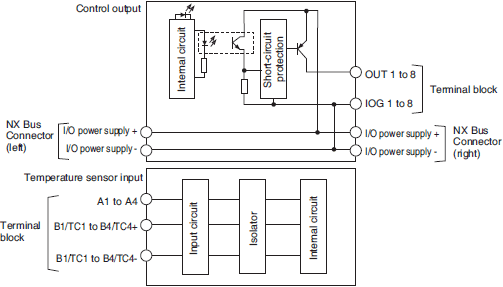 |
||||
| Installation orientation
and restrictions |
Mounting orientation:
• Connect to CPU Unit Front mounting orientation is possible • Connect to Communications Coupler Unit Six orientations are possible Limitation: The cold junction compensation error is limited by the mounting orientation and the type or power consumption of the adjacent Unit. For details, refer to Cold Junction Compensation Error Specifications for Units That Take a Thermocouple Input Type. |
||||
| Terminal connection
diagram |
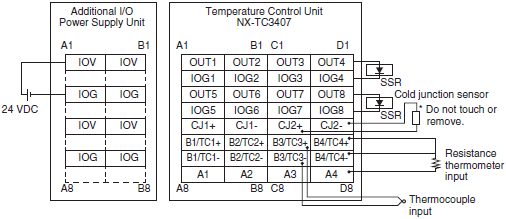 |
||||
*2. For details, refer to the Reference Accuracy and Temperature Coefficient Table.
For thermocouple inputs, reference accuracy and cold junction compensation error are guaranteed for a set of a
Temperature Control Unit and a terminal block on which a cold junction sensor is mounted.
Be sure to use the terminal block and the Temperature Control Unit with the same calibration control number
together.
A calibration control number is displayed both on the terminal block and the Unit.
In order to distinguish left and right terminal blocks, each terminal block has either a letter "L" (left side) or "R" (right
side) appended at the end of a calibration control number.
Make sure to return the terminal block to which a cold junction sensor is mounted and the Unit together.
*3. For details, refer to Cold Junction Compensation Error Specifications for Units That Take a Thermocouple Input Type.
Temperature Control Unit (4-Channel Type) NX-TC3408
| Unit name | Temperature Control Unit
(4-Channel Type) |
Model | NX-TC3408 | ||
|---|---|---|---|---|---|
| Number of Channels | 4 channels | Control type | Standard control | ||
| Number of points per
channel |
• Temperature input: 1 point
per channel (4 points per Unit) • CT input: None • Control Output: 1 point per channel (4 points per Unit) |
External connection
terminal |
Screwless clamping terminal
block (16 terminals x 2) |
||
| I/O refreshing method | Free-Run Refreshing | ||||
| Indicators | TS indicator and output
indicators  |
CT
Input section |
CT current
input range |
-- | |
| Input
resistance |
-- | ||||
| Connectable
CTs |
-- | ||||
| Maximum
heater current |
-- | ||||
| Resolution | -- | ||||
| Overall
accuracy (25°C) |
-- | ||||
| Influence of
temperature (0 to 55°C) |
-- | ||||
| Conversion
time |
-- | ||||
| Control
Output section |
Control output
type and number of control outputs per channel |
Linear current output, one
output per channel |
|||
| Internal I/O
common |
-- | ||||
| Control Period | -- | ||||
| Manipulated
variable |
-5 to +105% | ||||
| Sensor
Input section |
Temperature
sensor *1 |
• Thermocouple input: K, J, T,
E, L, U, N, R, S, B, C/W, PL II • Platinum resistance thermometer input: Pt100 (three-wire), JPt100 (three-wire), Pt1000 (three-wire) |
Resolution | 1/10,000 | |
| Input
conversion range |
±20°C of the input range
*2 |
Rated Voltage | 24 VDC | ||
| Absolute
maximum rating |
±130 mV | Operating Load
Voltage Range |
15 to 28.8 VDC | ||
| Input
impedance |
20 kΩ min. | Maximum load
current |
-- | ||
| Resolution | 0.1°C max. | Maximum
Inrush Current |
-- | ||
| Reference
accuracy |
*2 | Allowable load
resistance |
350 Ω or less, or greater than
350 Ω but no more than 600 Ω *3 |
||
| Temperature
coefficient |
*2 | Leakage
current |
-- | ||
| Cold junction
compensation error |
±1.2°C *2 *4 | Residual
voltage |
-- | ||
| Input
disconnection detection current |
Approx. 0.1 uA | Load Short-
circuit Protection |
-- | ||
| Input
detection current |
0.25 mA | Output range | 0 to 20 mA, 4 to 20 mA | ||
| Effect of
conductor resistance |
• Thermocouple input: 0.1°C/
Ω (100 Ω or less per conductor) • Platinum resistance thermometer input: 0.06°C/ Ω (20 Ω or less per conductor) |
Overall
accuracy (25°C) |
±0.3% of full scale, but 1% of
full scale at 0 to 4 mA of 0 to 20 mA range |
||
| Warm-up
period |
30 minutes | Influence of
temperature (0 to 55°C) |
±0.3% (full scale) | ||
| Conversion
time |
50 ms per Unit | ||||
| Dimensions | 24 mm (W) ×100 mm (H) ×
71 mm (D) |
Isolation method | • Between sensor inputs and
internal circuitry: Power = Transformer, Signal = Digital isolator • Between sensor inputs: Power = Transformer, Signal = Digital isolator • Between control output and internal circuit: Photocoupler • No isolation between control outputs |
||
| Insulation resistance | 20 MΩ min. between isolated
circuits (at 100 VDC) |
Dielectric strength | 510 VAC between isolated
circuits for 1 minute with a leakage current of 5 mA max. |
||
| I/O power supply
method |
Supplied from the NX bus. | Current capacity of I/O
power supply terminals |
IOG: 0.1 A max. per terminal | ||
| NX Unit power
consumption |
• Connected to a CPU Unit
1.65 W max. • Connected to Communications Coupler Unit 1.25 W max. |
Current consumption
from I/O power supply |
30 mA max. | ||
| Weight | 140 g max. | ||||
| Circuit configuration | 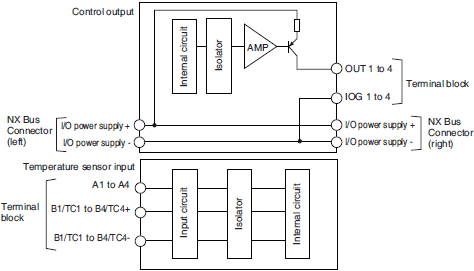 |
||||
| Installation orientation
and restrictions |
Mounting orientation:
• Connect to CPU Unit Front mounting orientation is possible • Connect to Communications Coupler Unit Six orientations are possible Limitation: The cold junction compensation error is limited by the mounting orientation and the type or power consumption of the adjacent Unit. For details, refer to Cold Junction Compensation Error Specifications for Units That Take a Thermocouple Input Type. |
||||
| Terminal connection
diagram |
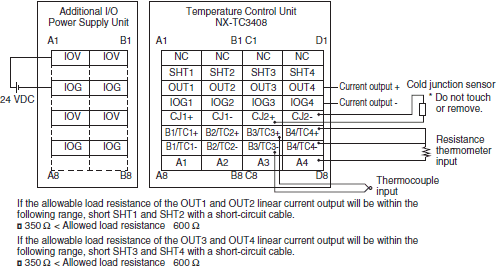 |
||||
*2. For details, refer to the Reference Accuracy and Temperature Coefficient Table.
For thermocouple inputs, reference accuracy and cold junction compensation error are guaranteed for a set of a
Temperature Control Unit and a terminal block on which a cold junction sensor is mounted.
Be sure to use the terminal block and the Temperature Control Unit with the same calibration control number
together.
A calibration control number is displayed both on the terminal block and the Unit.
In order to distinguish left and right terminal blocks, each terminal block has either a letter "L" (left side) or "R" (right
side) appended at the end of a calibration control number.
Make sure to return the terminal block to which a cold junction sensor is mounted and the Unit together.
*3. To use an allowable load resistance greater than 350 Ω but not exceeding 600 Ω, either SHT1 and SHT2, or SHT3 and
SHT4 must be shorted with a shorting cable.
For details, refer to the NX-series Temperature Control Units User’s Manual (Cat. No. W523).
*4. For details, refer to Cold Junction Compensation Error Specifications for Units That Take a Thermocouple Input Type.
Input types
The settings are shown in the following table.
| Setting name *1 | Display of
support software |
Description | Default | Setting
range |
Unit | Change
application timing |
|---|---|---|---|---|---|---|
| Ch[] input type | Ch[] Input Type | Sets the input type of
sensors connected to temperature input. |
5: K -200 to
1300°C |
*2 | No | After Unit restart |
*1.[] represents the channel number.
*2. The setting ranges are shown below. However, the 21, 22, and 23 input types can be used with Unit versions 1.2 and later.
| Set
values |
Input types | Input indication range | Remarks | |
|---|---|---|---|---|
| Sensor | Input setting range | |||
| 0 | Pt100 | -200 to 850°C/-300 to 1500°F | -220 to 870°C/-340 to 1540°F | Resistance
thermometer |
| 1 | Pt100 | -199.9 to 500.0°C/-199.9 to 900.0°F | -219.9 to 520.0°C/-239.9 to 940.0°F | |
| 2 | Pt100 | -0.0 to 100.0°C/0.0 to 210.0°F | -20.0 to 120.0°C/-40.0 to 250.0°F | |
| 3 | JPt100 | -199.9 to 500.0°C/-199.9 to 900.0°F | -219.9 to 520.0°C/-239.9 to 940.0°F | |
| 4 | JPt100 | -0.0 to 100.0°C/0.0 to 210.0°F | -20.0 to 120.0°C/-40.0 to 250.0°F | |
| 5 | K | -200 to 1300°C/-300 to 2300°F | -220 to 1320°C/-340 to 2340°F | Thermocouple |
| 6 | K | -20.0 to 500.0°C/0.0 to 900.0°F | -40.0 to 520.0°C/-40.0 to 940.0°F | |
| 7 | J | -100 to 850°C/-100.0 to 1500°F | -120 to 870°C/-140 to 1540°F | |
| 8 | J | -20.0 to 400.0°C/0.0 to 750.0°F | -40.0 to 420.0°C/-40.0 to 790.0°F | |
| 9 | T | -200 to 400°C/-300 to 700°F | -220 to 420°C/-340 to 740°F | |
| 10 | T | -199.9 to 400.0°C/-199.9 to 700.0°F | -219.9 to 420.0°C/-239.9 to 740°F | |
| 11 | E | -200 to 600°C/-300 to 1100°F | -220 to 620°C/-340 to 1140°F | |
| 12 | L | -100 to 850°C/-100 to 1500°F | -120 to 870°C/-140 to 1540°F | |
| 13 | U | -200 to 400°C/-300 to 700°F | -220 to 420°C/-340 to 740°F | |
| 14 | U | -199.9 to 400.0°C/-199.9 to 700.0°F | -219.9 to 420.0°C/-239.9 to 740°F | |
| 15 | N | -200 to 1300°C/-300 to 2300°F | -220 to 1320°C/-340 to 2340°F | |
| 16 | R | 0 to 1700°C/0 to 3000°F | -20 to 1720°C/-40 to 3040°F | |
| 17 | S | 0 to 1700°C/0 to 3000°F | -20 to 1720°C/-40 to 3040°F | |
| 18 | B | 0 to 1800°C/0 to 3200°F | -20 to 1820°C/-40 to 3240°F | |
| 19 | C/W | 0 to 2300°C/0 to 3200°F | -20 to 2320°C/-40 to 3240°F | |
| 20 | PLII | 0 to 1300°C/0 to 2300°F | -20 to 1320°C/-40 to 2340°F | |
| 21 | Pt1000 | -200 to 850°C/-300 to 1500°F | 220 to 870°C/-340 to 1540°F | Resistance
thermometer |
| 22 | Pt1000 | -199.9 to 500.0°C/-199.9 to 900.0°F | 219.9 to 520.0°C/-239.9 to 940.0°F | |
| 23 | Pt1000 | 0.0 to 100.0°C/0.0 to 210.0°F | 20.0 to 120.0°C/-40.0 to 250.0°F | |
Reference Accuracy and Temperature Coefficient Table
Reference accuracies and temperature coefficients are shown below by input type and measurement temperature.
To convert the temperature Unit from Celsius to Fahrenheit, use the following equation.
Fahrenheit temperature (°F) = Celsius temperature (°C) x 1.8 + 32
| Set
values |
Input type | Measurement
temperature (°C) |
Reference
accuracy °C (%) *2 |
Temperature coefficient
°C/°C *3 (ppm/°C *4) |
|
|---|---|---|---|---|---|
| Sensor | Temperature
range (°C) *1 |
||||
| 0 | Pt100 | -200 to 850 | -200 to 300 | ±1.0 (±0.1%) | ±0.1 (±100 ppm/°C) |
| 300 to 700 | ±2.0 (±0.2%) | ±0.2 (±200 ppm/°C) | |||
| 700 to 850 | ±2.5 (±0.25%) | ±0.25 (±250 ppm/°C) | |||
| 1 | Pt100 | -199.9 to 500.0 | -199.9 to 300.0 | ±0.8 (±0.12%) | ±0.1 (±150 ppm/°C) |
| 300.0 to 500.0 | ±0.8 (±0.12%) | ±0.2 (±300 ppm/°C) | |||
| 2 | Pt100 | 0.0 to 100.0 | 0.0 to 100.0 | ±0.8 (±0.8%) | ±0.1 (±1000 ppm/°C) |
| 3 | JPt100 | -199.9 to 500.0 | -199.9 to 300.0 | ±0.8 (±0.12%) | ±0.1 (±150 ppm/°C) |
| 300.0 to 500.0 | ±0.8 (±0.12%) | ±0.2 (±300 ppm/°C) | |||
| 4 | JPt100 | 0.0 to 100.0 | 0.0 to 100.0 | ±0.8 (±0.8%) | ±0.1 (±1000 ppm/°C) |
| 5 | K | -200 to 1300 | -200 to -100 | ±1.5 (±0.1%) | ±0.15 (±100 ppm/°C) |
| -100 to 400 | ±0.30 (±200 ppm/°C) | ||||
| 400 to 1300 | ±0.38 (±250 ppm/°C) | ||||
| 6 | K | -20.0 to 500.0 | -20.0 to 400.0 | ±1.0 (±0.2%) | ±0.30 (±600 ppm/°C) |
| 400.0 to 500.0 | ±0.38 (±760 ppm/°C) | ||||
| 7 | J | -100 to 850 | -100 to 400 | ±1.4 (±0.15%) | ±0.14 (±150 ppm/°C) |
| 400 to 850 | ±1.2 (±0.13%) | ±0.28 (±300 ppm/°C) | |||
| 8 | J | -20.0 to 400.0 | -20.0 to 400.0 | ±1.0 (±0.24%) | ±0.14 (±350 ppm/°C) |
| 9 | T | -200 to 400 | -200 to -100 | ±1.2 (±0.2%) | ±0.30 (±500 ppm/°C) |
| -100 to 400 | ±0.12 (±200 ppm/°C) | ||||
| 10 | T | -199.9 to 400.0 | -199.9 to -100.0 | ±1.2 (±0.2%) | ±0.30 (±500 ppm/°C) |
| -100.0 to 400.0 | ±0.12 (±200 ppm/°C) | ||||
| 11 | E | -200 to 600 | -200 to 400 | ±1.2 (±0.15%) | ±0.12 (±150 ppm/°C) |
| 400 to 600 | ±2.0 (±0.25%) | ±0.24 (±300 ppm/°C) | |||
| 12 | L | -100 to 850 | -100 to 300 | ±1.1 (±0.12%) | ±0.11 (±120 ppm/°C) |
| 300 to 700 | ±2.2 (±0.24%) | ±0.22 (±240 ppm/°C) | |||
| 700 to 850 | ±0.28 (±300 ppm/°C) | ||||
| 13 | U | -200 to 400 | -200 to 400 | ±1.2 (±0.2%) | ±0.12 (±200 ppm/°C) |
| 14 | U | -199.9 to 400.0 | -199.9 to 400.0 | ±1.2 (±0.2%) | ±0.12 (±200 ppm/°C) |
| 15 | N | -200 to 1300 | -200 to 400 | ±1.5 (±0.1%) | ±0.30 (±200 ppm/°C) |
| 400 to 1000 | |||||
| 1000 to 1300 | ±0.38 (±250 ppm/°C) | ||||
| 16 | R | 0 to 1700 | 0 to 500 | ±1.75 (±0.11%) | ±0.44 (±260 ppm/°C) |
| 500 to 1200 | ±2.5 (±0.15%) | ||||
| 1200 to 1700 | |||||
| 17 | S | 0 to 1700 | 0 to 1700 | ±2.5 (±0.15%) | ±0.44 (±260 ppm/°C) |
| 18 | B | 0 to 1800 | 0 to 400 | Reference accuracy
cannot be guaranteed |
Reference accuracy
cannot be guaranteed |
| 400 to 1200 | ±3.6 (±0.2%) | ±0.45 (±250 ppm/°C) | |||
| 1200 to 1800 | ±5.0 (±0.28%) | ±0.54 (±300 ppm/°C) | |||
| 19 | C/W | 0 to 2300 | 0 to 300 | ±1.15 (±0.05%) | ±0.46 (±200 ppm/°C) |
| 300 to 800 | ±2.3 (±0.1%) | ||||
| 800 to 1500 | ±3.0 (±0.13%) | ||||
| 1500 to 2300 | ±0.691 (±300 ppm/°C) | ||||
| 20 | PL II | 0 to 1300 | 0 to 400 | ±1.3 (±0.1%) | ±0.23 (±200 ppm/°C) |
| 400 to 800 | ±2.0 (±0.15%) | ±0.39 (±300 ppm/°C | |||
| 800 to 1300 | ±0.65 (±500 ppm/°C) | ||||
| 21 | Pt1000 | -200 to 850 | -200 to 300 | ±1.0 (±0.1%) | ±0.1 (±100ppm/°C) |
| 300 to 700 | ±2.0 (±0.2%) | ±0.2 (±200ppm/°C) | |||
| 700 to 850 | ±2.5 (±0.25%) | ±0.25 (±250ppm/°C) | |||
| 22 | Pt1000 | -199.9 to 500.0 | -199.9 to 300.0 | ±0.8 (±0.12%) | ±0.1 (±150ppm/°C) |
| 300.0 to 500.0 | ±0.2 (±300ppm/°C) | ||||
| 23 | Pt1000 | 0.0 to 100.0 | 0.0 to 100.0 | ±0.8 (±0.8%) | ±0.1 (±1000ppm/°C) |
measured value error, round up calculation results in accordance with the decimal point position of the temperature
range.
*2. The overall accuracy of the Temperature Control Unit is guaranteed for a set consisting of a cold junction sensor that
is mounted on the terminal block and a Temperature Control Unit. Be sure to use the terminal block and Temperature
Control Unit with the same calibration control number together. For the 24mm width model, also be sure the left and
right terminal blocks are correctly attached.
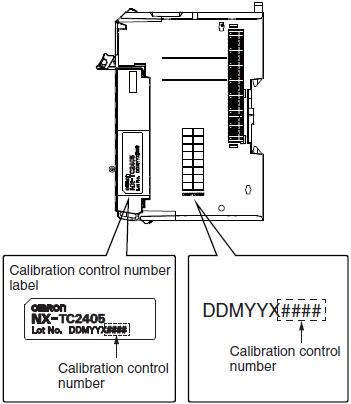
The following formula is used to calculate the error of the measured value for thermocouple inputs..
Overall accuracy = Reference accuracy + Temperature characteristic x Change in the ambient temperature + Cold
junction compensation error For resistance thermometer inputs, there is no cold junction compensation error.
(Calculation example)
Conditions
| Item | Description |
|---|---|
| Ambient temperature | 30°C |
| Measured value | 100°C |
| Thermocouple | K: -200 to 1300°C |
The characteristic values are formulated from the datasheet or reference accuracy and temperature coefficient table under the above conditions
| Item | Description |
|---|---|
| Reference accuracy | -100 to 400°C: ±1.5°C |
| Temperature coefficient | -100 to 400°C: ±0.30°C/°C |
| Change in the ambient temperature | 25°C -> 30°C 5 deg |
| Cold junction compensation error | ±1.2°C |
Overall accuracy = Reference accuracy + Temperature characteristic x Change in the ambient temperature +
Cold junction compensation error
= ±1.5°C +(±0.30°C/°C) x 5 deg + ±1.2°C
= ±4.2°C
-200 to 1300°C without decimal point. the calculation result is round up after the decimal point.
Then the overall accuracy is ±5°C.
*4. The ppm value is for the full scale of the temperature range.
Cold Junction Compensation Error Specifications for Units That Take a Thermocouple Input Type
This section describes the cold junction compensation errors for thermocouple inputs, which differ by installation orientation of this Unit, type of adjacent Units, and current consumed by the adjacent Units.
When the Adjacent Units are Temperature Control Units
This section describes the cold junction compensation errors when the adjacent Units are Temperature Control Units. The error differs by installation orientation.
(a) For upright installation
The cold junction compensation error is ±1.2°C.
However, there are exceptions depending on the input type and temperature. Those conditions and the cold junction compensation error are as in the table below.
| Input type and temperature range | Cold junction compensation error |
|---|---|
| T below -90°C | ±3.0°C |
| J, E, K and N below -100°C | |
| U, L and PLII | |
| R and S below 200°C | |
| B below 400°C | Not guaranteed |
| C/W | ±3.0°C |
(b) For other than upright installation
The cold junction compensation error is ±4.0°C.
However, there are exceptions depending on the input type and temperature. Those conditions and the cold junction compensation error are as in the table below.
| Input type and temperature range | Cold junction compensation error |
|---|---|
| T below -90°C | ±7.0°C |
| J, E, K and N below -100°C | |
| U, L and PLII | |
| R and S below 200°C | |
| B below 400°C | Not guaranteed |
| C/W | ±9.0°C |
When the Adjacent Units are not Temperature Control Units
This section describes the cold junction compensation errors when the adjacent Units are not Temperature Control Units. The error differs by the installation orientation and power consumption by the adjacent Units.
(a) For upright installation, when the power consumption is 1.5 W or less for both the left and right adjacent Units
The cold junction compensation error is ±1.2°C.
However, there are exceptions depending on the input type and temperature. Those conditions and the cold junction compensation error are as in the table below.
| Input type and temperature range | Cold junction compensation error |
|---|---|
| T below -90°C | ±3.0°C |
| J, E, K and N below -100°C | |
| U, L and PLII | |
| R and S below 200°C | |
| B below 400°C | Not guaranteed |
| C/W | ±3.0°C |
Or for any installation other than upright, when the power consumption of both the left and right adjacent Units is
less than 3.9 W
The cold junction compensation error is ±4.0°C.
However, there are exceptions depending on the input type and temperature. Those conditions and the cold junction compensation error are as in the table below.
| Input type and temperature range | Cold junction compensation error |
|---|---|
| T below -90°C | ±7.0°C |
| J, E, K and N below -100°C | |
| U, L and PLII | |
| R and S below 200°C | |
| B below 400°C | Not guaranteed |
| C/W | ±9.0°C |
(c) When the power consumption exceeds 3.9 W for either the left or right adjacent Unit
Do not use the above condition (c) because the cold junction compensation error is not guaranteed in this condition.
(d) The power consumption of adjacent Units
The power consumption of adjacent Units is the total of the following values.
• The power consumption of the NX Unit power supply and I/O power supply for the NX Units adjacent to the Temperature Input Unit. If the adjacent Unit is an Input Unit, it is the total power consumption according to the input current.
Version Information
Connected to a CPU Unit
Refer to the user's manual for the CPU Unit for details on the CPU Units to which NX Units can be connected.
| NX Unit | Corresponding version *1 | ||
|---|---|---|---|
| Model | Unit Version | CPU Unit | Sysmac Studio |
| NX-TC2405 | Ver.1.0 | Ver. 1.13 | Ver.1.21 |
| Ver.1.1 | Ver.1.22 | ||
| Ver.1.2 | Ver.1.30 | ||
| Ver.1.3 | Ver.1.40 | ||
| NX-TC2406 | Ver.1.0 | Ver.1.21 | |
| Ver.1.1 | Ver.1.22 | ||
| Ver.1.2 | Ver.1.30 | ||
| Ver.1.3 | Ver.1.40 | ||
| NX-TC2407 | Ver.1.0 | Ver.1.21 | |
| Ver.1.1 | Ver.1.22 | ||
| Ver.1.2 | Ver.1.30 | ||
| Ver.1.3 | Ver.1.40 | ||
| NX-TC2408 | Ver.1.0 | Ver.1.21 | |
| Ver.1.1 | Ver.1.22 | ||
| Ver.1.2 | Ver.1.30 | ||
| Ver.1.3 | Ver.1.40 | ||
| NX-TC3405 | Ver.1.0 | Ver.1.21 | |
| Ver.1.1 | Ver.1.22 | ||
| Ver.1.2 | Ver.1.30 | ||
| Ver.1.3 | Ver.1.40 | ||
| NX-TC3406 | Ver.1.0 | Ver.1.21 | |
| Ver.1.1 | Ver.1.22 | ||
| Ver.1.2 | Ver.1.30 | ||
| Ver.1.3 | Ver.1.40 | ||
| NX-TC3407 | Ver.1.0 | Ver.1.21 | |
| Ver.1.1 | Ver.1.22 | ||
| Ver.1.2 | Ver.1.30 | ||
| Ver.1.3 | Ver.1.40 | ||
| NX-TC3408 | Ver.1.0 | Ver.1.21 | |
| Ver.1.1 | Ver.1.22 | ||
| Ver.1.2 | Ver.1.30 | ||
| Ver.1.3 | Ver.1.40 | ||
support is provided by the oldest available version after the specified version. Refer to the user's manuals for the
specific Units for the relation between models and versions.
Connected to a Communications EtherCAT Coupler Unit
| NX Unit | Corresponding version *1 | |||
|---|---|---|---|---|
| Model | Unit Version | EtherCAT Coupler Unit | CPU Unit or Industrial PC | Sysmac Studio |
| NX-TC2405 | Ver.1.0 | Ver.1.0 *2 | Ver. 1.05 | Ver.1.21 |
| Ver.1.1 | Ver.1.22 | |||
| Ver.1.2 | Ver.1.30 | |||
| Ver.1.3 | Ver.1.40 | |||
| NX-TC2406 | Ver.1.0 | Ver.1.21 | ||
| Ver.1.1 | Ver.1.22 | |||
| Ver.1.2 | Ver.1.30 | |||
| Ver.1.3 | Ver.1.40 | |||
| NX-TC2407 | Ver.1.0 | Ver.1.21 | ||
| Ver.1.1 | Ver.1.22 | |||
| Ver.1.2 | Ver.1.30 | |||
| Ver.1.3 | Ver.1.40 | |||
| NX-TC2408 | Ver.1.0 | Ver.1.21 | ||
| Ver.1.1 | Ver.1.22 | |||
| Ver.1.2 | Ver.1.30 | |||
| Ver.1.3 | Ver.1.40 | |||
| NX-TC3405 | Ver.1.0 | Ver.1.21 | ||
| Ver.1.1 | Ver.1.22 | |||
| Ver.1.2 | Ver.1.30 | |||
| Ver.1.3 | Ver.1.40 | |||
| NX-TC3406 | Ver.1.0 | Ver.1.21 | ||
| Ver.1.1 | Ver.1.22 | |||
| Ver.1.2 | Ver.1.30 | |||
| Ver.1.3 | Ver.1.40 | |||
| NX-TC3407 | Ver.1.0 | Ver.1.21 | ||
| Ver.1.1 | Ver.1.22 | |||
| Ver.1.2 | Ver.1.30 | |||
| Ver.1.3 | Ver.1.40 | |||
| NX-TC3408 | Ver.1.0 | Ver.1.21 | ||
| Ver.1.1 | Ver.1.22 | |||
| Ver.1.2 | Ver.1.30 | |||
| Ver.1.3 | Ver.1.40 | |||
support is provided by the oldest available version after the specified version. Refer to the User’s manuals for the
specific Units for the relation between models and versions.
*2. When you connect the Unit to a master of other manufacturer, use an EtherCAT Coupler Unit with Unit version 1.5 or later.
Connected to a Communications EtherNet/IP Coupler Unit
| NX Unit | Corresponding version*1 | ||||||
|---|---|---|---|---|---|---|---|
| Model | Unit
Version |
Application with an NJ/NX/NY-series
Controller *2 |
Application with an CS/CJ/CP-series
PLC *3 |
||||
| EtherNet/IP
Coupler Unit |
CPU Unit or
Industrial PC |
Sysmac
Studio |
EtherNet/IP
Coupler Unit |
Sysmac
Studio |
NX-IO
Configurator |
||
| NX-TC2405 | Ver.1.0 | Ver.1.2 | Ver.1.14 | Ver.1.21 | Ver. 1.2 | Ver.1.21 | Ver.1.21 |
| Ver.1.1 | Ver.1.22 | Ver.1.22 | Ver.1.22 | ||||
| Ver.1.2 | Ver.1.30 | Ver.1.30 | Ver.1.21 | ||||
| Ver.1.3 | Ver.1.40 | Ver.1.40 | Ver.1.22 | ||||
| NX-TC2406 | Ver.1.0 | Ver.1.21 | Ver.1.21 | Ver.1.21 | |||
| Ver.1.1 | Ver.1.22 | Ver.1.22 | Ver.1.22 | ||||
| Ver.1.2 | Ver.1.30 | Ver.1.30 | Ver.1.21 | ||||
| Ver.1.3 | Ver.1.40 | Ver.1.40 | Ver.1.22 | ||||
| NX-TC2407 | Ver.1.0 | Ver.1.21 | Ver.1.21 | Ver.1.21 | |||
| Ver.1.1 | Ver.1.22 | Ver.1.22 | Ver.1.22 | ||||
| Ver.1.2 | Ver.1.30 | Ver.1.30 | Ver.1.21 | ||||
| Ver.1.3 | Ver.1.40 | Ver.1.40 | Ver.1.22 | ||||
| NX-TC2408 | Ver.1.0 | Ver.1.21 | Ver.1.21 | Ver.1.21 | |||
| Ver.1.1 | Ver.1.22 | Ver.1.22 | Ver.1.22 | ||||
| Ver.1.2 | Ver.1.30 | Ver.1.30 | Ver.1.21 | ||||
| Ver.1.3 | Ver.1.40 | Ver.1.40 | Ver.1.22 | ||||
| NX-TC3405 | Ver.1.0 | Ver.1.21 | Ver.1.21 | Ver.1.21 | |||
| Ver.1.1 | Ver.1.22 | Ver.1.22 | Ver.1.22 | ||||
| Ver.1.2 | Ver.1.30 | Ver.1.30 | Ver.1.21 | ||||
| Ver.1.3 | Ver.1.40 | Ver.1.40 | Ver.1.22 | ||||
| NX-TC3406 | Ver.1.0 | Ver.1.21 | Ver.1.21 | Ver.1.21 | |||
| Ver.1.1 | Ver.1.22 | Ver.1.22 | Ver.1.22 | ||||
| Ver.1.2 | Ver.1.30 | Ver.1.30 | Ver.1.21 | ||||
| Ver.1.3 | Ver.1.40 | Ver.1.40 | Ver.1.22 | ||||
| NX-TC3407 | Ver.1.0 | Ver.1.21 | Ver.1.21 | Ver.1.21 | |||
| Ver.1.1 | Ver.1.22 | Ver.1.22 | Ver.1.22 | ||||
| Ver.1.2 | Ver.1.30 | Ver.1.30 | Ver.1.21 | ||||
| Ver.1.3 | Ver.1.40 | Ver.1.40 | Ver.1.22 | ||||
| NX-TC3408 | Ver.1.0 | Ver.1.21 | Ver.1.21 | Ver.1.21 | |||
| Ver.1.1 | Ver.1.22 | Ver.1.22 | Ver.1.22 | ||||
| Ver.1.2 | Ver.1.30 | Ver.1.30 | Ver.1.21 | ||||
| Ver.1.3 | Ver.1.40 | Ver.1.40 | Ver.1.22 | ||||
support is provided by the oldest available version after the specified version. Refer to the user's manuals for the
specific Units for the relation between models and versions.
*2. Refer to the user's manual of the EtherNet/IP Coupler Unit for the Unit versions of EtherNet/IP Units corresponding to
EtherNet/IP Coupler Units.
*3. Refer to the user's manual of the EtherNet/IP Coupler Unit for the Unit versions of CPU Units and EtherNet/IP Units
corresponding to EtherNet/IP Coupler Units.
last update: December 1, 2023

